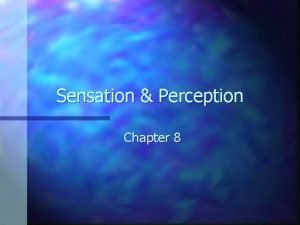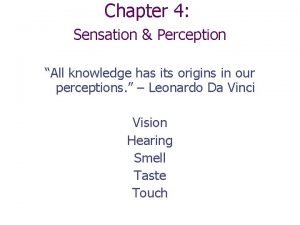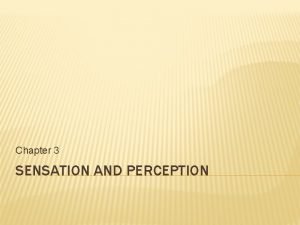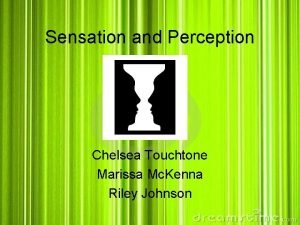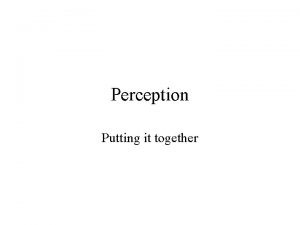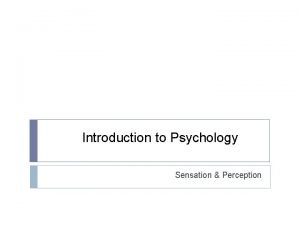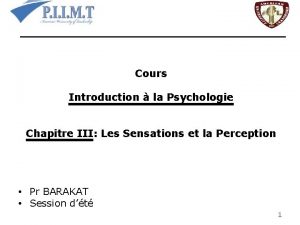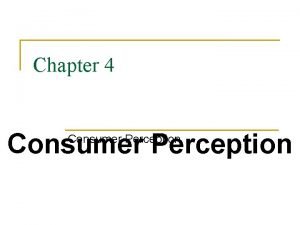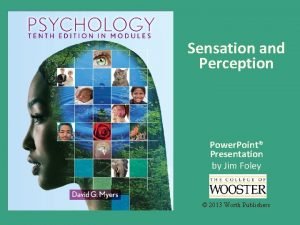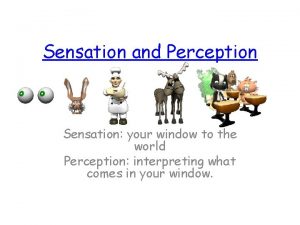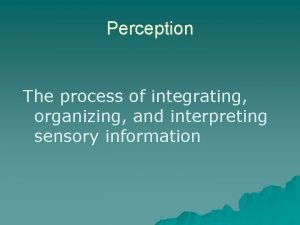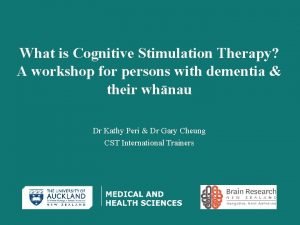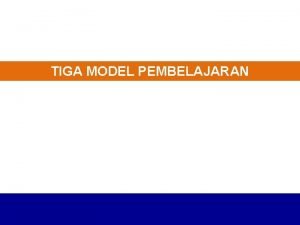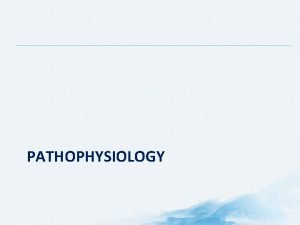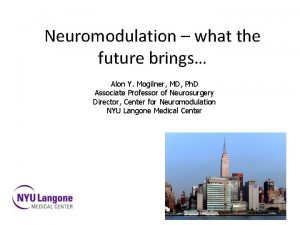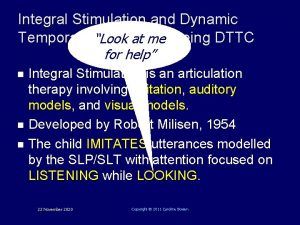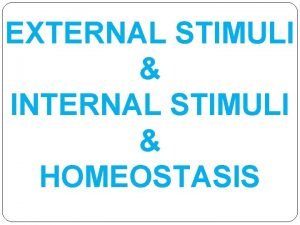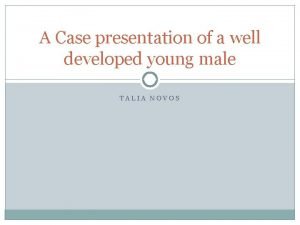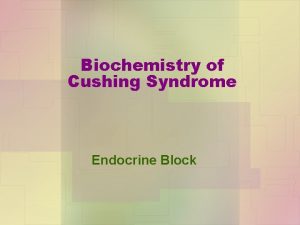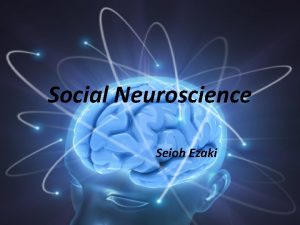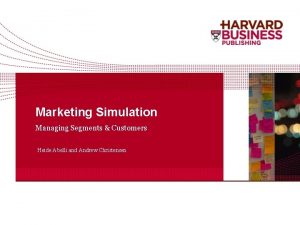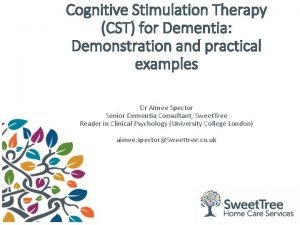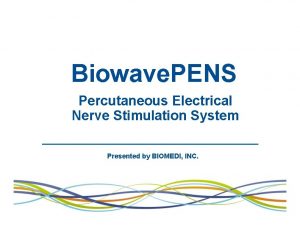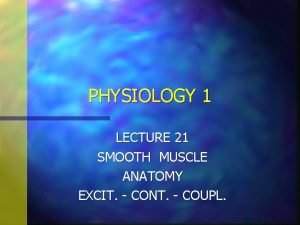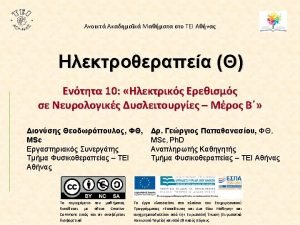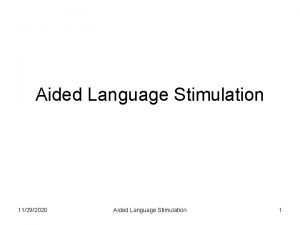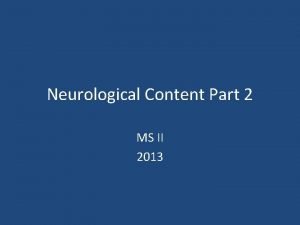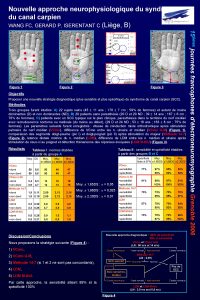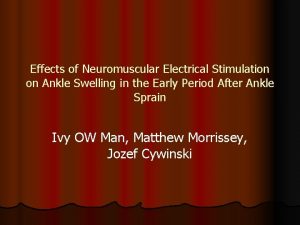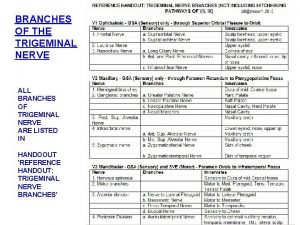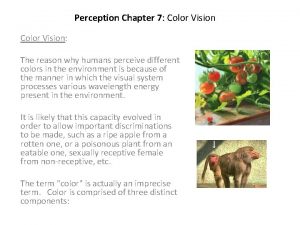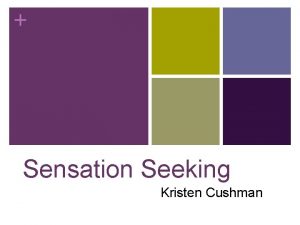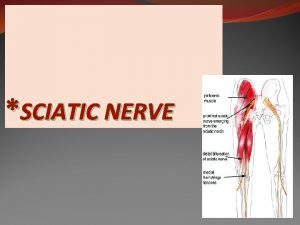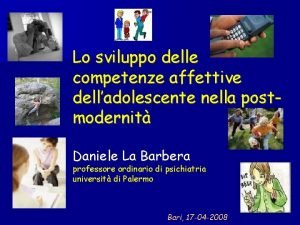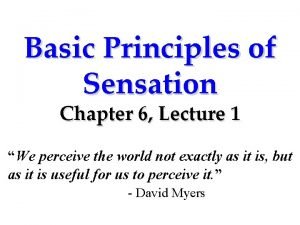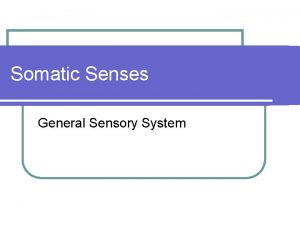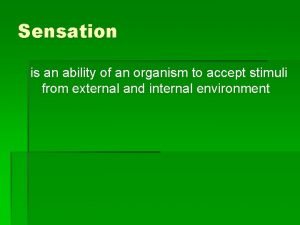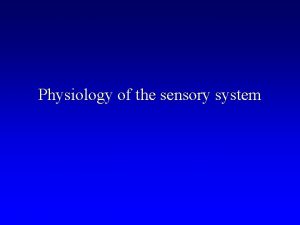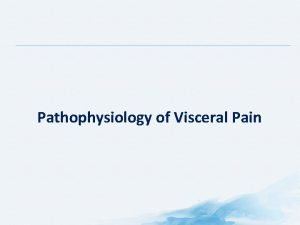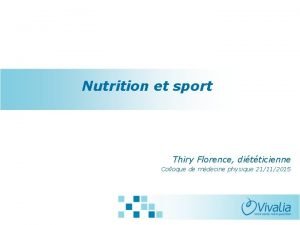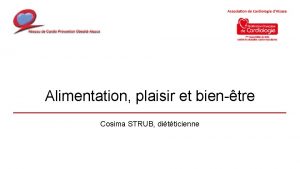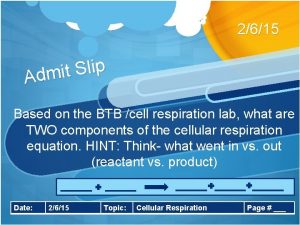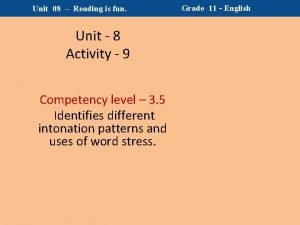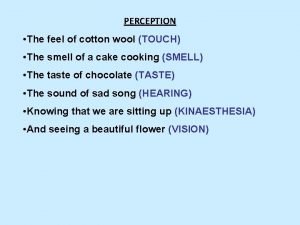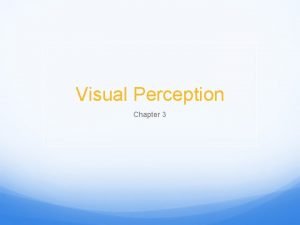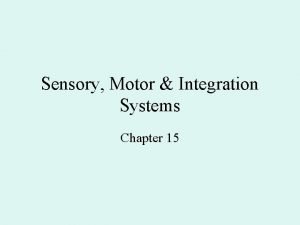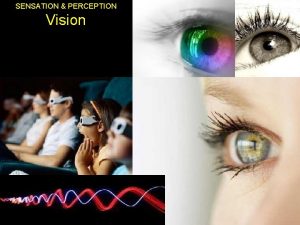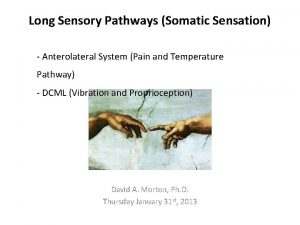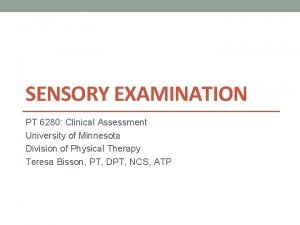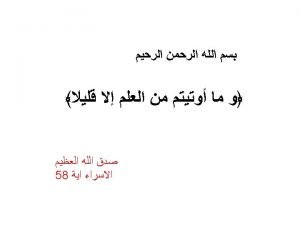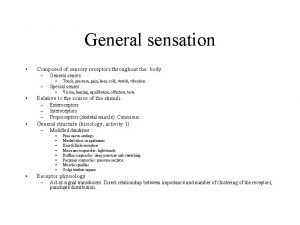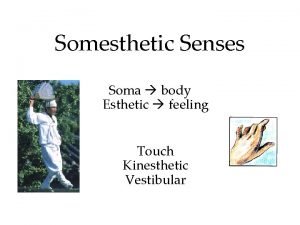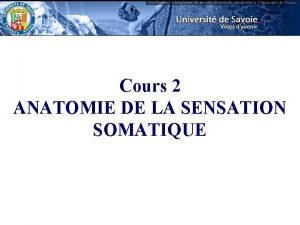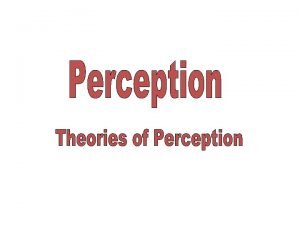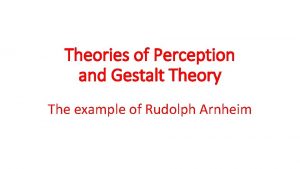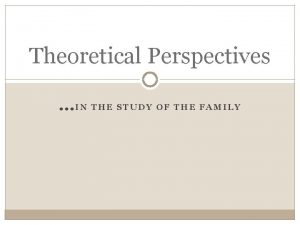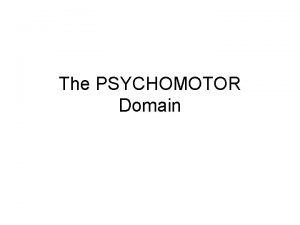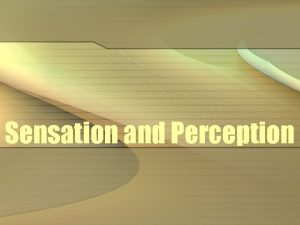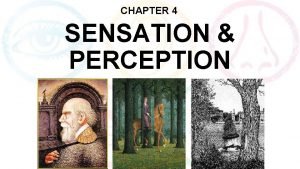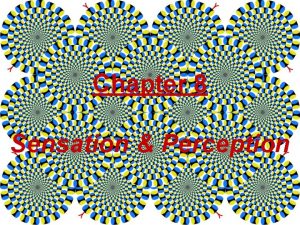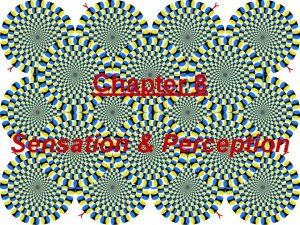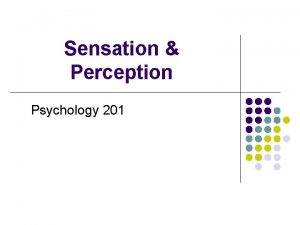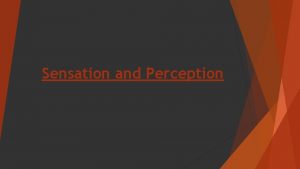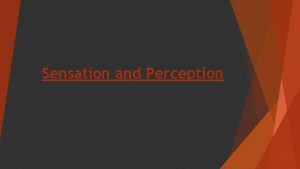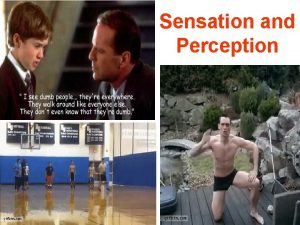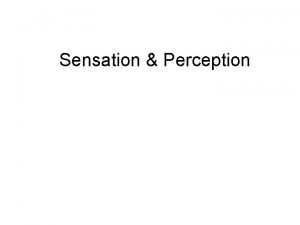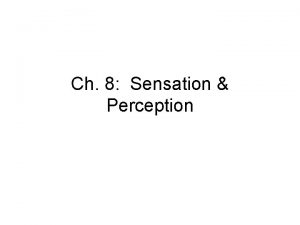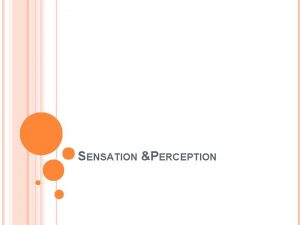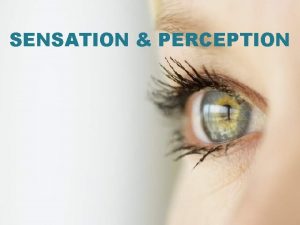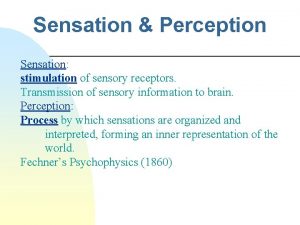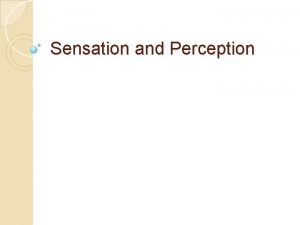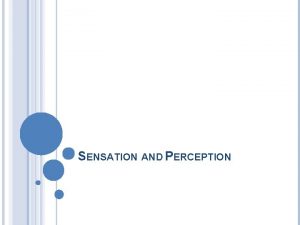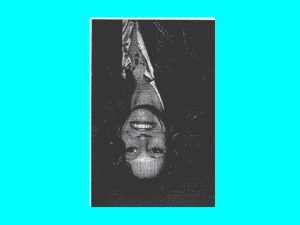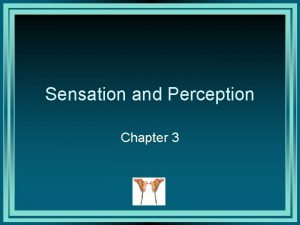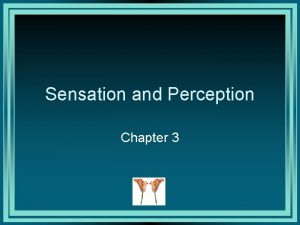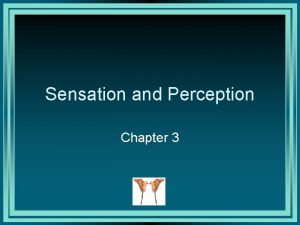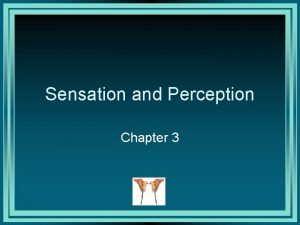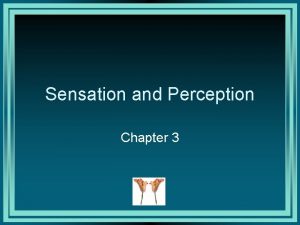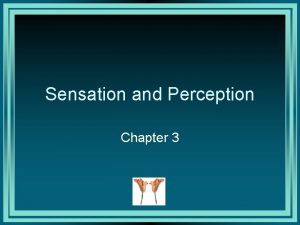Chapter 4 Sensation Perception Introduction Sensation stimulation of













































































- Slides: 77

Chapter 4: Sensation & Perception

Introduction �Sensation = stimulation of sense organs. �Perception = selection, organization, and interpretation of sensory input

An Overview of Sensation to Perception

The Visual System: Essentials of Sight

The Visual Stimulus – Light } Light travels in waves with two important properties • Wavelength, perceived as color • Amplitude, perceived as brightness

Properties of Light � Purity = how varied the mix of wavelengths; influences perception of the saturation, or richness, of colors

The Eye: A Living Optical Instrument �Eyes serve 2 main purposes: • channels light to neural tissue that receives it, called the retina, • houses that tissue.

The Anatomy of the Eye

The Retina: The Brain’s Envoy in the Eye �Retina = neural tissue in eye that absorbs light, processes images, & sends visual signals to the brain.

Rods and Cones } } Rods – for viewing dim light with no color Cones – for bright light with color

The Eye: A Living Optical Instrument �Distant objects appear blurry to nearsighted people & close objects appear blurry to farsighted people.

Dark and Light Adaptation �Involves changes in retina’s sensitivity to light. • dark adaptation - eyes become more sensitive to light in low illumination • Light adaptation- eyes become less sensitive to light in high illumination.

Information Processing in the Retina �Collection of rod & cone receptors that funnel signals to particular visual cell in retina (or brain) make up that cell’s receptive field. �Receptive fields areas in the retina that affect the firing of visual cells.

Vision and the Brain �The optic nerves from the inside half of each eye cross at the optic chiasm and then project to the opposite half of the brain.

Visual Pathways

Information Processing in the Visual Cortex �After processing in primary visual cortex, visual information is shuttled along the what and where pathways to other cortical areas.

Where Pathways �The dorsal stream, or where pathway, processes information about motion & depth, moves on to areas of the parietal lobe.

What Pathway �The ventral stream, or what pathway, processes info about color & form, moves on to areas of the temporal lobe. • has neurons inside that are especially sensitive to faces.

What and Where Pathways from the Primary Visual Cortex

�Research suggests visual cortex contains cells that function as feature detectors. • feature detectors = neurons that respond selectively to very specific features of more complex stimuli.

The Stimulus for Color �Subtractive color mixing = removing some wavelengths of light, leaving less light than was originally there. • E. g. yellow + blue = greeen

The Stimulus for Color �Additive color mixing = superimposing lights, putting more light in the mixture than exists in any one light by itself. • E. g. shining a red, green & blue spotlight on white surface.

Trichromatic Theory of Color Vision } Perception of color is based on the response rates of three kinds of cones

Opponent-Process Theory of Color Vision } Proposes the existence of “opposing” redgreen, blue-yellow, and black-white channels

Theories of Color Vision � Perception of color appears to involve stages of information processing � Receptors that do first stage of processing (cones) seem to follow the principles outlined in trichromatic theory. � Later stages of processing seem to follow the principles outlined in opponent process theory.

The Visual System: Perceptual Processes

Perceiving Forms, Patterns, and Objects �Perceptual set—a readiness to perceive a stimulus in a particular way. • creates a certain slant in how you interpret sensory input.

Perceiving Forms, Patterns, and Objects �Inattentional blindness = failure to see fully visible objects or events in a visual display because one’s attention is focused elsewhere.

Figure and Ground �The figure is the thing being looked at, & the ground is the background against which it stands. �Dividing visual displays into figure & ground is fundamental way in which people organize visual perceptions.

Figure 4. 16 The Principle of Figure and Ground.

Feature Analysis: Assembling Forms �Feature analysis = detecting specific elements in visual input & assembling them into a more complex form.

Bottom-Up Vs. Top-Down Processing

Looking at the Whole Picture: Gestalt Principles �Gestalt psychology basic assumption - that the whole can be greater than the sum of its parts.

Gestalt (con’t) �Gestalt psychologists formulated series of principles that describe how visual system organizes a scene into discrete forms.

Gestalt Principles �Proximity = Things that are near one another seem to belong together. �Similarity = group stimuli that are similar.

Gestalt Principles �Simplicity = Pragnanz, (German as “good form); people tend to organize forms in the simplest way possible.

Gestalt Principles �Continuity = reflects people’s tendency to follow in whatever direction they’ve been led. � Source : Microsoft Clip. Art

Gestalt Principles: �The Gestalt principles of proximity, similarity, continuity, closure, and simplicity explain how we group elements into higher -order forms.

How do we get an accurate view of the world? �Perceptual hypothesis = inference about what form could be responsible for a pattern of sensory stimulation.

Perceiving Depth or Distance �Depth perception = interpretation of visual cues that indicate how near or far away objects are. � Source: Microsoft Clip. Art

Binocular Cues � Binocular depth cues = clues about distance based on differing views of the two eyes. � Retinal disparity = objects within 25 feet project images to slightly different locations on the right and left retinas, so the right and left eyes see slightly different views of the object. � Source: Microsoft Clip. Art

Monocular Cues �Monocular depth cues = clues about distance based on image in either eye alone. �Depth perception depends primarily on monocular cues

Monocular Cues � 2 kinds of monocular cues to depth: • Active use of the eye in viewing the world. • Pictorial depth cues—cues about distance that can be given in a flat picture.

Pictorial Cues to Depth

Cultural Variations �People from pictureless societies have some difficulty in applying pictorial depth cues to two-dimensional pictures.

Perceptual Constancies in Vision �A perceptual constancy is a tendency to experience a stable perception in the face of continually changing sensory input.

The Power of Misleading Cues: Visual Illusions �Visual illusion = inexplicable discrepancy between the appearance of a visual stimulus and its physical reality.

The Müller-Lyer illusion. Go ahead, measure them: The two vertical lines are of equal length.

7 Best Optical Illusions of All Time

The Auditory System: Hearing

The Stimulus: Sound �Sound waves = vibrations of molecules, which means that they must travel through some physical medium, such as air.

Sound Waves � Characterized by wavelength (frequency), amplitude, and purity � Wavelength = perceptions of pitch � Amplitude = perceptions of loudness � Purity = key determinant of timbre.

Human Hearing Capacities �Wavelengths are described in terms of their frequency, which is measured in cycles per second, or hertz (Hz). �Humans can hear frequency ranging from 20 Hz up to 20, 000 Hz.

Human Hearing Capacities �The greater the amplitude of sound waves, the louder the sound perceived. • measured in decibels (d. B). • loudness ultimately depends on an interaction between amplitude and frequency.

Human Hearing Capacities � Very loud sounds can have negative effects on the quality of your hearing. Even brief exposure to sounds over decibels can be painful and may cause damage to your auditory system ( Daniel, 2007). In recent years there has been great concern about hearing loss in young people using personal listening devices who play their music too loudly ( Morata, 2007). Portable music players can easily deliver over decibels through headphones. One study found significant hearing impairment in of the young people sampled (Peng, Tao, Huang, 2009).

Human Hearing Capacities �The purity or complexity of a sound influences how timbre is perceived. • (e. g. think of a note with precisely the same loudness & pitch played on a piano and then on a violin. The difference you perceive in the sounds is a difference in timbre).

Sensory Processing in the Ear �External �Middle �Inner ear = vibration of air molecules. ear = vibration of movable bones. = waves in a fluid, �which are finally converted into a stream of neural signals sent to the brain ( Moore, 2001).

Sensory Processing in the Ear �The external ear consists mainly of the pinna, a sound-collecting cone. �Sound waves funneled along the auditory canal toward the eardrum, a taut membrane that vibrates in response.

Sensory Processing in the Ear �Vibrations of eardrum are transmitted inward by a mechanical chain made up of the three tiniest bones in your body (the hammer, anvil, and stirrup), known collectively as the ossicles.

Sensory Processing in the Ear �Inner ear consists largely of the cochlea, a fluid-filled, coiled tunnel that contains the receptors for hearing. �Basilar membrane = runs length of the spiraled cochlea, holds the auditory receptors, called hair cells.

Sensory Processing in the Ear

The Other Senses Taste, Smell, and Touch

Taste: The Gustatory System �Gustatory receptors = clusters of taste cells found in taste buds that line trenches around tiny bumps on the tongue.

Taste: The Gustatory System �The taste buds are sensitive to four basic tastes: sweet, sour, bitter, and salty. �Umami taste. (savory) may qualify as a fifth basic

Taste: The Gustatory System �Sensitivity to these tastes is distributed unevenly across the tongue, but variations are small. �Taste signals are routed through thalamus and sent on to insular cortex in frontal lobe.

Taste: The Gustatory System � Supertasters = more sensitive to some tastes than nontasters, with medium tasters falling in between. � Nontasters = more susceptible to lure of sweets, high-fat foods, alcohol, & smoking, tend to be less healthy than those of supertasters. � Women are. more likely to be supertasters than men

Taste: The Gustatory System �sensory adaptation—a gradual decline in sensitivity to prolonged stimulation.

Smell: The Olfactory System �Physical stimuli = chemical substances— volatile ones that can evaporate and be carried in the air. �These chemical stimuli are dissolved in fluid—specifically, the mucus in the nose.

Smell: The Olfactory System �The receptors for smell are olfactory cilia, hairlike structures located in the upper portion of the nasal passages ( Getchell & Getchell, 1991).

Smell: The Olfactory System � Olfactory receptors have axons that synapse with cells in olfactory bulb & then are routed directly to olfactory cortex in temporal lobe & other areas in cortex (Scott, 2008). � Most of these receptors respond to more than one odor. � Smell is the only sensory system that is not routed through the thalamus before it projects onto the cortex.

Smell: The Olfactory System �Sensory �When adaptation occurs in smell. compared to other mammals, humans may have a better sense of smell than previously thought.

The Olfactory System

Touch: Sensory Systems in the Skin �Skin houses many types of sensory receptors. �Responds to pressure, temperature, & pain. �Tactile localization depends on receptive fields similar to those seen for vision.

Touch: Sensory Systems in the Skin �Pain signals are sent to brain along two pathways that are characterized as fast and slow. �Perception of pain is highly subjective and may be influenced by culture, mood, and contextual factors.

Touch: Sensory Systems in the Skin �Gate-control theory holds that incoming pain sensations must pass through a “gate” in the spinal cord that can be closed, thus blocking ascending pain signals.

Touch: Sensory Systems in the Skin �Endorphins & a descending neural pathway appear responsible for this suppression of pain. �Glial cells contribute to the modulation of chronic pain. � Source: Miscrosoft Clip. Art

Homework �Read Chapter 5 for next class. �Personal Paper Due March 2 nd. • Your paper will be 2 -pages (double-spaced, 12 point Times New Roman font, 1 in margins). • Include the following subheadings in your paper: �Summary of Ted. Talk �Connection to Course �Personal Connection
 Chapter 5 sensation and perception
Chapter 5 sensation and perception Chapter 3 sensation and perception
Chapter 3 sensation and perception Chapter 6 sensation and perception
Chapter 6 sensation and perception Chapter 4 sensation and perception test
Chapter 4 sensation and perception test Kinesthesis and vestibular sense
Kinesthesis and vestibular sense Sensation perception
Sensation perception Chapter 4 sensation and perception
Chapter 4 sensation and perception Chapter 3 sensation and perception
Chapter 3 sensation and perception Gestalt visual principles
Gestalt visual principles Perceptual set ap psych
Perceptual set ap psych What is sensation and perception
What is sensation and perception Perception
Perception Perceptual system
Perceptual system Sensation and perception
Sensation and perception Cours sur la perception en psychologie
Cours sur la perception en psychologie Sensation and perception in marketing
Sensation and perception in marketing Perception vs sensation
Perception vs sensation Webers law
Webers law Opponent process theory
Opponent process theory Face recognition
Face recognition Sensation and perception uu
Sensation and perception uu Cognitive stimulation therapy training course
Cognitive stimulation therapy training course Discovery learning adalah
Discovery learning adalah Noxious stimulation
Noxious stimulation Occipital nerve stimulation
Occipital nerve stimulation Dynamic temporal and tactile cueing
Dynamic temporal and tactile cueing What is external and internal stimuli
What is external and internal stimuli Cortisol stimulation test results
Cortisol stimulation test results Crh stimulation test interpretation
Crh stimulation test interpretation Acth stimulation test
Acth stimulation test Idealized influence leader examples
Idealized influence leader examples Transcranial magnetic stimulation
Transcranial magnetic stimulation Shrouding in slaughtering
Shrouding in slaughtering Heide abelli
Heide abelli Cognitive stimulation therapy training course
Cognitive stimulation therapy training course Biowave electrical stimulation
Biowave electrical stimulation Besoins cognitifs
Besoins cognitifs Muscle stimulation
Muscle stimulation Sensory stimulation theory
Sensory stimulation theory Ems brain stimulation
Ems brain stimulation Aided language stimulation
Aided language stimulation Stimulation nerf tibial postérieur
Stimulation nerf tibial postérieur Coma stimulation techniques
Coma stimulation techniques Integrated brand promotion
Integrated brand promotion Docteur iserentant
Docteur iserentant Electronic muscle stimulation ankle sprain
Electronic muscle stimulation ankle sprain Selective demand stimulation example
Selective demand stimulation example Foramen ovale trigeminal nerve
Foramen ovale trigeminal nerve Chapter 7 vision and perception
Chapter 7 vision and perception Chapter 7 managing risk vision and perception
Chapter 7 managing risk vision and perception Sensation seeking
Sensation seeking Branches of sciatic nerve
Branches of sciatic nerve Sensation seeking significato
Sensation seeking significato 6 principles of sensation
6 principles of sensation Exteroceptors
Exteroceptors Sensation
Sensation Classification of sensation
Classification of sensation Viscerosomatic levels
Viscerosomatic levels Ditticienne base sur coute sensation
Ditticienne base sur coute sensation Ditticienne base sur coute sensation
Ditticienne base sur coute sensation What causes the burning sensation in your muscles
What causes the burning sensation in your muscles Vocabulary activity 8-1 sensation answer key
Vocabulary activity 8-1 sensation answer key Cotton wool sensation
Cotton wool sensation Sensation
Sensation Sensation
Sensation Opponent process theory vs trichromatic theory
Opponent process theory vs trichromatic theory Dcml sensation
Dcml sensation Thinking feeling sensing intuiting
Thinking feeling sensing intuiting Cortical sensory loss
Cortical sensory loss Touch receptor in skin
Touch receptor in skin Nociceptive sensation
Nociceptive sensation Tectorial membrane
Tectorial membrane What are the somesthetic senses
What are the somesthetic senses Sensation somatique
Sensation somatique Gregory top down theory of perception
Gregory top down theory of perception Gestalt theory of perception examples
Gestalt theory of perception examples Perspective vs perception
Perspective vs perception Perception in psychomotor domain
Perception in psychomotor domain





